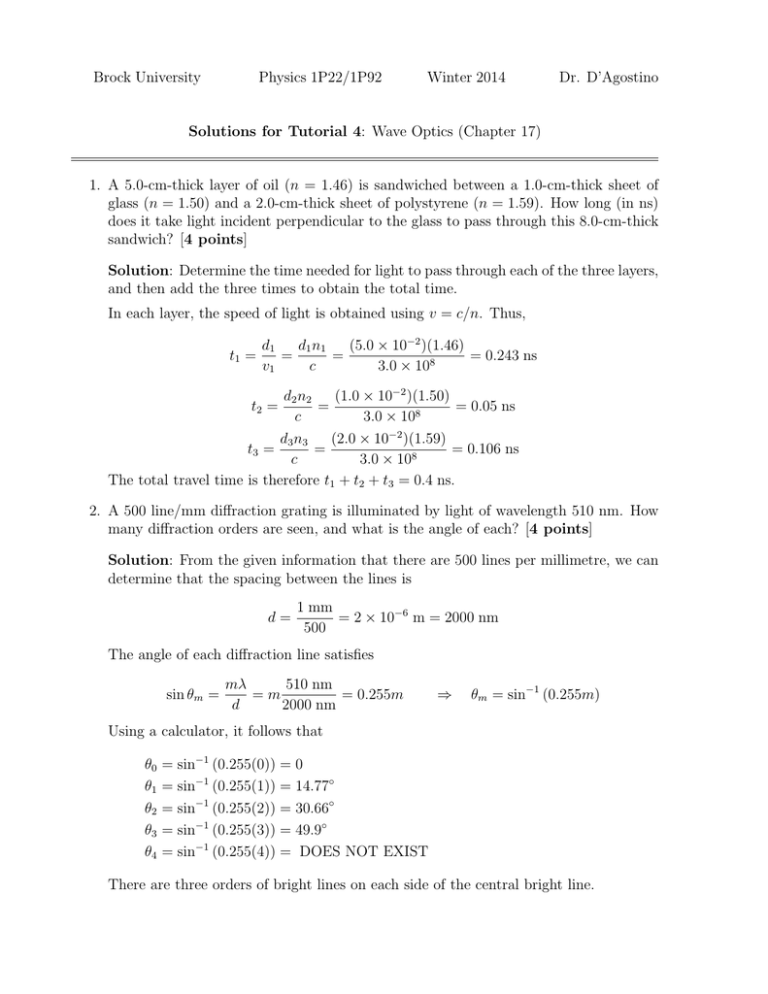Solutions for Tutorial 4
advertisement

Brock University Physics 1P22/1P92 Winter 2014 Dr. D’Agostino Solutions for Tutorial 4: Wave Optics (Chapter 17) 1. A 5.0-cm-thick layer of oil (n = 1.46) is sandwiched between a 1.0-cm-thick sheet of glass (n = 1.50) and a 2.0-cm-thick sheet of polystyrene (n = 1.59). How long (in ns) does it take light incident perpendicular to the glass to pass through this 8.0-cm-thick sandwich? [4 points] Solution: Determine the time needed for light to pass through each of the three layers, and then add the three times to obtain the total time. In each layer, the speed of light is obtained using v = c/n. Thus, t1 = d1 n1 (5.0 × 10−2 )(1.46) d1 = = = 0.243 ns v1 c 3.0 × 108 t2 = d2 n2 (1.0 × 10−2 )(1.50) = = 0.05 ns c 3.0 × 108 d3 n3 (2.0 × 10−2 )(1.59) = = 0.106 ns c 3.0 × 108 The total travel time is therefore t1 + t2 + t3 = 0.4 ns. t3 = 2. A 500 line/mm diffraction grating is illuminated by light of wavelength 510 nm. How many diffraction orders are seen, and what is the angle of each? [4 points] Solution: From the given information that there are 500 lines per millimetre, we can determine that the spacing between the lines is d= 1 mm = 2 × 10−6 m = 2000 nm 500 The angle of each diffraction line satisfies sin θm = mλ 510 nm =m = 0.255m d 2000 nm ⇒ θm = sin−1 (0.255m) Using a calculator, it follows that θ0 θ1 θ2 θ3 θ4 = sin−1 (0.255(0)) = 0 = sin−1 (0.255(1)) = 14.77◦ = sin−1 (0.255(2)) = 30.66◦ = sin−1 (0.255(3)) = 49.9◦ = sin−1 (0.255(4)) = DOES NOT EXIST There are three orders of bright lines on each side of the central bright line. 3. A sheet of glass is coated with a 500-nm-thick layer of oil (n = 1.42). [4 points] For which visible wavelengths of light do the reflected waves interfere (a) constructively? (b) destructively? (c) What is the colour of reflected light? (d) What is the colour of transmitted light? Solution: Assume that the glass has an index of refraction n = 1.50 (see table on Page 547 of textbook). Then as light from the air reflects from the air-oil interface, it undergoes a phase change. Similarly, when light from inside the oil reflects from the oil-glass interface, it also undergoes a phase change. Thus, for constructive interference of the reflected waves, the path difference must be a whole number of wavelengths: λm 2t = m noil where t is the thickness of the oil layer. The wavelengths of light that work satisfy 2tnoil 2(500)(1.42) 1420 nm λm = = = m m m Using a calculator, the first few wavelengths can be determined: λ1 = 1420 nm 1420 = 710 nm λ2 = 2 1420 λ3 = = 473 nm 3 1420 λ4 = = 355 nm (etc.) 4 The only wavelength in the visible range is the 473 nm wave, which is blue. (The 710 nm wave is slightly in the infrared region, but it might be barely visible as red light.) Thus, the colour of reflected light is blue. On the other hand, for destructive interference of the reflected waves, the path difference should be a “half-integer” multiple of the wavelength: 2(500)(1.42) 1420 nm 2tnoil λm = = 1 = 1 m+ 2 m+ 2 m + 21 Using a calculator, the first few wavelengths can be determined: 1420 λ0 = = 2840 nm 0.5 1420 = 947 nm λ1 = 1.5 1420 λ2 = = 568 nm 2.5 1420 λ3 = = 406 nm 3.5 and so on. Waves with wavelength 406 nm (violet) and 568 nm (green) are visible. Thus, the colour of transmitted light is violet and green.